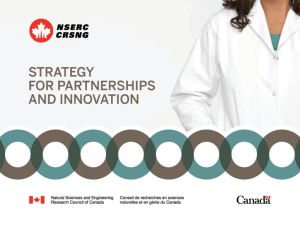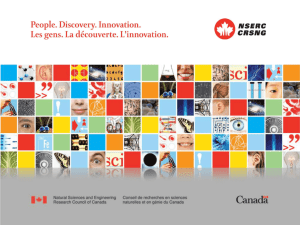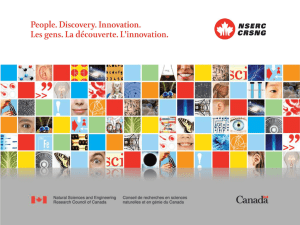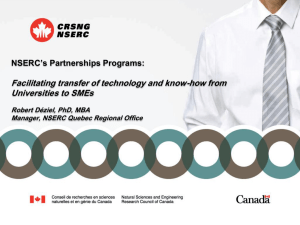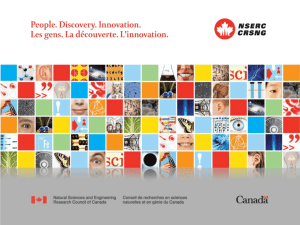Document 11430876
advertisement
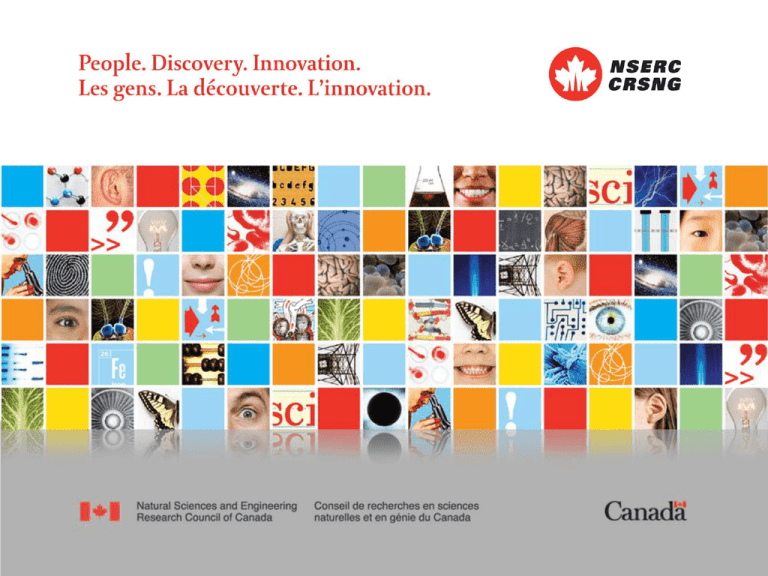
Simon Fraser University Research Partnerships Overview Tuesday January 26, 2016 Monika Michalska Research Partnerships 2 Presentation Outline 1. What’s new at NSERC? 2. Overview of Research Partnerships 3. What’s new in Strategic Partnerships? 4. CRD, Strategic Partnership Grants, IRCs 5. Questions 3 $1.1 billion dollars 11,300 professors 3,000+ Canadian companies 30,500 post-secondary students and post-doctoral fellows “Making Canada a country of discoverers and innovators for the benefit of all Canadians” What’s New at NSERC New VP of Research Partnerships – Bettina Hamelin NSERC 2020 Strategy Launched in December 2015 New Federal Government 5 NSERC 2020 1.Foster a science and engineering culture in Canada 2.Launch the new generation 3.Build a diversified and competitive research base 4.Strengthen the dynamic between discovery and innovation 5.Go global Research Partnerships NSERC’s Innovation Goal Connect and apply the strength of the academic research system to addressing the opportunities and challenges of building prosperity for Canada. The Rationale Canadian industry needs to access the academic intellectual capabilities that are built through Government’s investment in postsecondary R&D thereby realizing more value for Canada Our Partnership Program Drivers The Canadian business competitiveness in the context of a global economy Capacity and Critical Mass – academic research and training Research Partnerships NSERC Support Across the DiscoveryInnovation Dynamic Centres for Commercialization and Research MARKET MATURITY Business-Led Networks Industry-driven programs basic research; research applied to industry Particle Physics Sustainable Technologies for Energy Production Systems (STEPS) Strategic Partnerships (Government Priorities) Discovery Grants Ecology/ Hydrogeology GreenCentre Canada (GCC) Ultrasonic detection of manufacturing defects Clean Energy Chemistry (reduce use of water in oil sands production) TRAINING in UNIVERSITIES TRAINING with INDUSTRY TECHNOLOGY MATURITY Research Partnerships Excellence + Partnership = NSERC’s Research Partnerships Program Requirements Excellence across all criteria • Scientific merit, originality and research competence • Training of HQP (exposure to new environments and challenges) • Plan to apply research results, benefit to Canada Program attributes • Involve industry and/or government partners • De-risk & increase investments by partners • Expand the expertise of partners and hiring of HQP • Accelerate knowledge and technology exploitation and exchange • Expand the technical and entrepreneurial skills of students • Require accountability: regular reporting NSERC and NCE Partnerships Program Landscape INNOVATION ENGAGE COLLABORATE COMMERCIALIZE CELEBRATE Connect with colleges & universities Collaborative R&D with colleges and universities Idea to Innovation for colleges &universities Synergy Awards for Innovation Engage with colleges & universities Industrial Research Chairs at college and universities Centres of Excellence for Commercialization and Research Student Training in Industry Strategic Partnerships with universities College Technology Access Centres Networks of Centres of Excellence Building College Capacity Research Partnership Budget for 2015-2016 Total Budget: $298.5M Building College Capacity 7% Commercialize 4% Engage 19% Strategic Partnerships 27% Industrial Research Chair 11% Celebrate 0% Collaborative Research and Development 32% Engage Collaborate Source: CCPP Commercialize Celebrate What’s new for Strategic? • NEW target areas • New context, new research topics • Strategic Networks – need only address broad target area 12 How NSERC Establishes Updated Target Areas and Research Topics Review of target areas and research topics undertaken every 5 years in order to align with current national priorities; Available budget requires supporting focused challenges (SPG is the only Partnerships program with defined target areas) Review process established in consultation with and approved by Committee on Research Partnerships and NSERC Council Broad consultation of research community within industry, academia and government Expert panel for each target area to define key research challenges 13 Updated Target Areas and Research Topics 4 national priorities aligned with NSERC mandate were selected as the target areas: o o o o Environment and Agriculture Natural Resources and Energy Information and Communications Technologies Advanced Manufacturing 4 to 6 research topics selected within each target area Refinement of research topics and challenges over the course of the next five years, as required, to ensure that they stay relevant in the context of Canada’s important research challenges http://www.nserc-crsng.gc.ca/Professors-Professeurs/RPP-PP/SPGTargetAreasSPSDomainesCibles_eng.asp 14 Budget for Priority Research Topics • Research outside the 4 priority target areas will not be considered for funding • Research within target area + Outside research topics = Exceptional Opportunity (MUST be self-identified) Exceptional Opportunities In: priority research topics 20% 80% Out: exceptional priorities 15 Strengthening and Maintaining a Longer Term Collaboration Collaborative R&D Grant (CRD) The objective to give companies access to the unique knowledge, expertise, and educational resources available at Canadian postsecondary institutions. The mutually beneficial collaborations are expected to result in industrial and/or economic benefits to Canada. • Industry driven R&D project • Shared costs: Each $1 cash and $1 in-kind from company levers up to $2 from NSERC • Flexible - Entire R&D spectrum - Duration 1-5 years - Small to large projects - Apply at any time Success rate: 85% Not competition-based Strategic Partnership Grants • Objective: To increase research and training in targeted areas that could strongly enhance Canada’s economy, society and/or environment within the next 10 years. • Research and training is conducted through a partnership between academic researchers and industry or government organizations. • Available budget requires supporting focused challenges. • SPG is the only program with set target areas. Strategic Partnership Grants Strategic Partnership GrantProject (SPG-P) Strategic Partnership Grant-Network (SPG-N) • Accelerate research in identified target areas of national and/or government priority • No cash required, in-kind is mandatory • Competition-based • Success rate: 20-25% • Large-scale, multi-disciplinary projects in targeted areas that require a network approach • Competition-based • Success rate: 25-30% Strategic Partnership Grants: Selection Criteria SPG-N • • • • • • Merit of the Research Proposal Need for a Network Approach Training Interactions and Partnerships Management and Budget Benefits to Canada and the Partners Peer Review • • • • LOI evaluation External reviewers Site Visit Committee Selection Panel CRD and Strategic Grants - Criteria CRD Strategic Scientific merit Originality of the research Research competence Quality of the research Project work plan Quality of the applicants as researchers Contribution to the training of HQP Training potential Private-sector support Interactions with the supporting organizations Industrial relevance Benefit to Canada Benefits to Canada and the supporting organizations Equally rated criteria CRD and Strategic - evaluations CRD Strategic No deadline Annual competition – April 1 1-5 years 1-3 years, typically 3 years No max or min, average is about 80k/year No max or min, average is about 173k/year Peer review; site visit and ACUIG for large CRDs Peer review and panel Not ranked ranked Not sector specific Sector specific – targeted Success rate of about 80% Success rate of about 25% Must meet criteria Equally rated criteria 21 CRD and Strategic - requirements CRD Strategic Eligible partner Eligible partner Cash + in-kind; NSERC leverages contributions Only in-kind is required Eligible applicant Eligible applicant Letter of support + F183a from partner(s) Letter of support + F183a from partner(s) 22 Longer Term Collaboration, Prestigious Appointment Industrial Research Chair (IRC) The objective is to assist universities in building on existing strengths to achieve the critical mass required for a major research endeavour; assist in the development of research efforts in fields that have not yet been developed in Canadian universities and provide an enhanced training • Industry driven R&D project • Shared costs: 1:1 cash leverage from NSERC • Flexible - Entire R&D spectrum - 5 year term, renewable - program of research - Apply at any time Not competition-based • 3 types of IRCs - Associate - Senior - Executive IRC Selection Criteria • Excellence of the candidate Commensurate with the type of Chair requested • Quality of the proposal • Industrial relevance and benefits • Training of highly qualified personnel • Benefits to the university • Appropriateness of the setting IRC Evaluation Process • • Site Visit – Committee of experts in the field (4-7 people, usually 5 or 6) – Meet at university • Chair candidate • University administration • Representatives from all industrial partners – Site Visit Report forms basis of a recommendation to fund or not ACUIG – Site Visit Report provided to NSERC’s interdisciplinary Advisory Committee on University-Industry Grants (ACUIG) for final recommendation to Council then the RP Vice-President signs the final decision, most often based on this recommendation NSERC staff available throughout the process What’s in it for you? Opportunity to apply your research, your ideas to applied problems Better training for students, that have experience both in the university and working with an industrial partner Increased funding for you, opportunity to build a lasting partnership, see your ideas implemented What’s in it for the Partners? Access to: • Team of researchers with expertise in a desired area to solve a problem • Technology/idea of commercial interest • Research facilities and infrastructure that the industry lacks • A potential source of highly qualified personnel Competitive edge in global markets 27 Who is a supporting organization? • Have a demonstrated interest in the project • Be involved in all stages of the research (help to develop the proposal, interact with researchers and students, provide input to the project) • Validate the results of the research • Provide guidance concerning exploitation of results 28 Writing a Successful Proposal • Engage industry partner(s) from the start - Defining project - Preparing application -Strong letters of support • Close collaboration throughout the project - In-kind contribution - Cash as well • HQP training (undergraduate, graduate and PDF level) - Appropriate level for work proposed - Describe their roles • Ensure all expertise needed is present - Describe roles of co-applicants, collaborators and research staff • Tangible benefits to Canada • Guidelines followed and requirements addressed • Clear summary, proposal easy to read • Pay attention to all aspects of the proposal and all criteria, not just the research proposal Resources For questions relating to fit to target area, eligibility of partners or applicants or Program requirements for Strategic Partnerships, please send your query to: STRGR@nserc-crsng.gc.ca For other RP programs: RPP@nserc-crsng.gc.ca 613-995-1111 For questions/support regarding the on-line application process, please contact: Helpdesk: (613) 995-4273 webapp@nserc-crsng.gc.ca 30 Questions? Monika Michalska 613-995-8124 monika.michalska@nserc-crsng.gc.ca Manager MCT Research Partnerships 31
